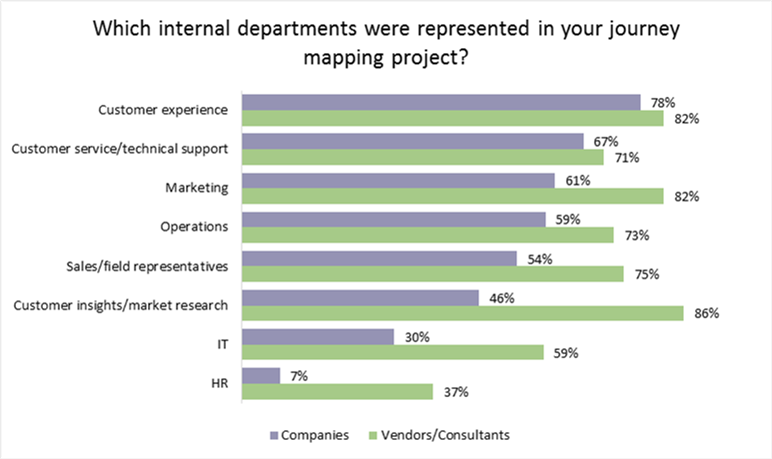Culture is the biggest determinant of effective customer experience. While that’s especially evident in the service space, it’s also true for every other type of company. When your culture focuses more on its own viewpoint than your customers’, you end up with convoluted processes, terrible return policies, and overly-complicated products.
That’s why I was happy to see some of the results from our first-ever journey mapping survey. We’re finalizing the analysis, which will be available soon. So, here’s a teaser about some of the results that are relevant to building a customer-focused culture.
When asked what was most important for an effective journey mapping project, both in-house practitioners and vendor/consultants agreed. Driving change requires a broad-cross-functional team.
That matches our experience. If you don’t involve a part of the company in the journey mapping process, then they won’t be committed to implementing the required changes. And it’s too late to bring your journey map to them after the fact. They need to be there on Day 1.
The natural next question is which functions participants involve in their journey mapping project. That’s when we received a surprise. Only 7% of practitioners reported that they involved HR in their latest journey map.
Actually, it wasn’t a complete surprise. We knew from our experience that HR is rarely involved in customer experience programs. We just expected it to be more than 7%. And that highlights a missed opportunity.
I realize that at some companies HR is more about compliance than culture change. But certainly not at 93% of companies! The numbers were a bit better when we asked the vendors. While HR was still the least-represented group, at least they reported involving them 37% of the time.
I just had a first-hand experience on the impact of culture. I was staying at a Marriott property while visiting a client. And in one night, I experienced the following issues:
- No light bulb in the lamp in my room.
- No heat in my room – it was at 63 degrees.
- When I reported that there was no heat, I was told that maintenance was gone for the day, and I’d have to wait until tomorrow.
- When the housekeeping representative brought me an extra comforter, he suggested I stop by the front desk in the morning to report the issue. I asked him why I had to do that. He said he’d leave a note, but I should stop by just to make sure.
- When I couldn’t sleep, I asked for a manager. I was told the manager knew about my issue, but had gone home. And there were no other rooms available.
- When I got ready for bed, I stepped in cold water on the floor – the result of a leaking toilet.
- When I went to take a shower, the shower caddy was broken, so the shampoo and conditioner fell out.
- When I stopped by the front desk in the morning, they had no record of my heater being broken.
- And, just to top it off, the spot for the coffee carafe was empty. No sleep and no coffee.
While these appear at first to be operational issues, they really aren’t. No process map would fix this They speak to a culture that’s broken, with no empathy and no empowerment.
This is obviously an extreme situation. But it emphasizes the role of culture in a customer experience. While the impact of a poor culture is transparent in service companies, it applies to any experience. Just look at Volkswagen or Samsung. Wells Fargo is another extreme example of culture’s impact on your customer experience.
The main lesson: As you’re getting ready to kick off your next customer experience project, take a lesson from our journey mapping survey, and include a broad, cross-functional team. Then go one step further, and make sure to bring in HR. Because every customer experience project is a culture project.





